Tourism Development in India: Geography, Flows, and Future
VerifiedAdded on 2023/06/15
|16
|1955
|480
Report
AI Summary
This report provides a comprehensive analysis of tourism development in India, beginning with a description of its physical and human geography, including climate, population distribution, and languages. It then critically examines the pattern of tourism flows, highlighting states with the highest travel rates and the impact of e-visas on foreign tourist arrivals. The report identifies several factors influencing tourism development, such as environmental conditions, socio-economic factors, accessibility, and historical and cultural attractions. Finally, it discusses implications for the future of tourism in India, considering factors like increasing demand and employment opportunities in the tourism sector. The report concludes that India is a prominent tourist destination due to its diverse cultures and historical significance.

Running head: TOURISM IN INDIA
Tourism in India
Tourism in India
Paraphrase This Document
Need a fresh take? Get an instant paraphrase of this document with our AI Paraphraser
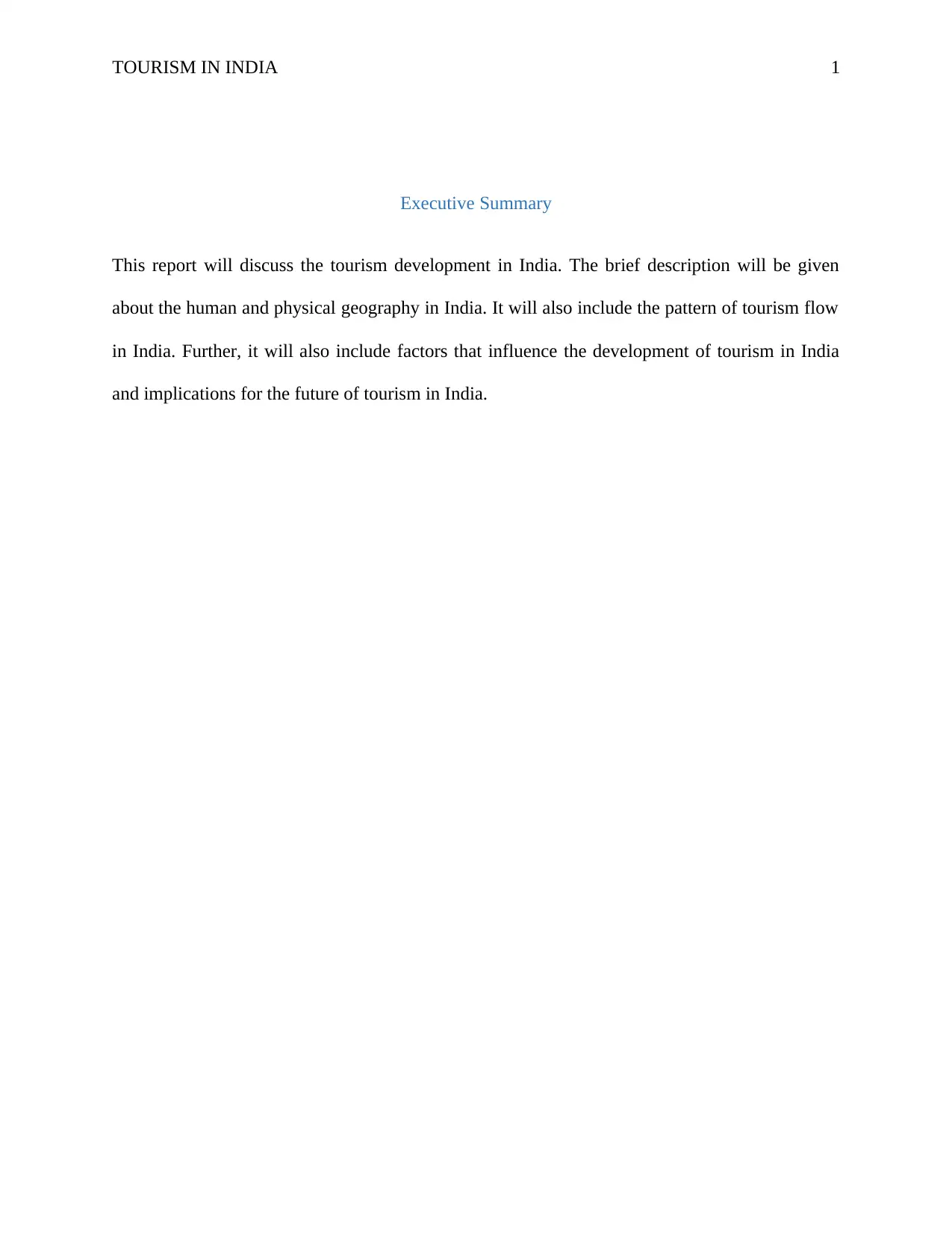
TOURISM IN INDIA 1
Executive Summary
This report will discuss the tourism development in India. The brief description will be given
about the human and physical geography in India. It will also include the pattern of tourism flow
in India. Further, it will also include factors that influence the development of tourism in India
and implications for the future of tourism in India.
Executive Summary
This report will discuss the tourism development in India. The brief description will be given
about the human and physical geography in India. It will also include the pattern of tourism flow
in India. Further, it will also include factors that influence the development of tourism in India
and implications for the future of tourism in India.
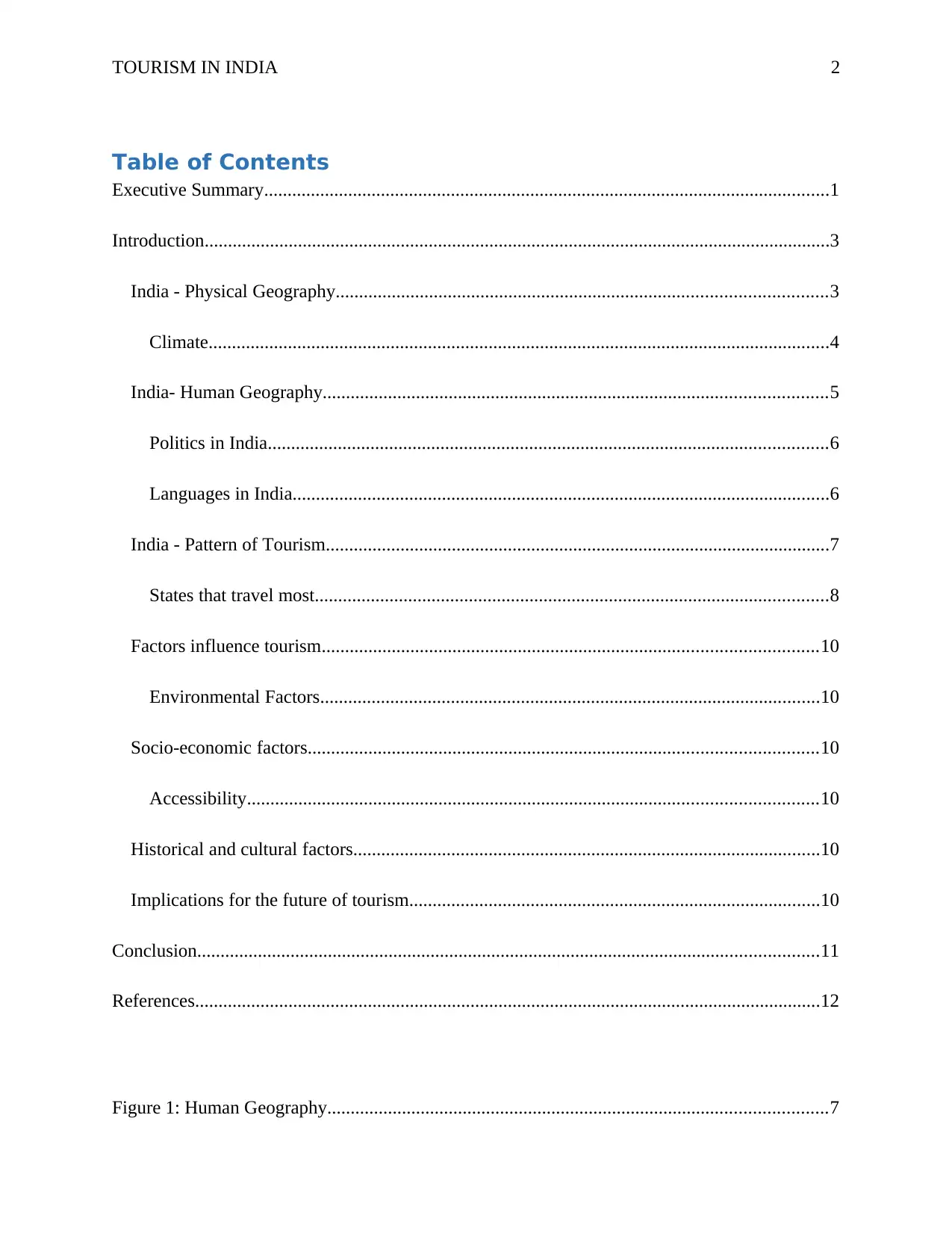
TOURISM IN INDIA 2
Table of Contents
Executive Summary.........................................................................................................................1
Introduction......................................................................................................................................3
India - Physical Geography.........................................................................................................3
Climate.....................................................................................................................................4
India- Human Geography............................................................................................................5
Politics in India........................................................................................................................6
Languages in India...................................................................................................................6
India - Pattern of Tourism............................................................................................................7
States that travel most..............................................................................................................8
Factors influence tourism..........................................................................................................10
Environmental Factors...........................................................................................................10
Socio-economic factors.............................................................................................................10
Accessibility..........................................................................................................................10
Historical and cultural factors....................................................................................................10
Implications for the future of tourism........................................................................................10
Conclusion.....................................................................................................................................11
References......................................................................................................................................12
Figure 1: Human Geography...........................................................................................................7
Table of Contents
Executive Summary.........................................................................................................................1
Introduction......................................................................................................................................3
India - Physical Geography.........................................................................................................3
Climate.....................................................................................................................................4
India- Human Geography............................................................................................................5
Politics in India........................................................................................................................6
Languages in India...................................................................................................................6
India - Pattern of Tourism............................................................................................................7
States that travel most..............................................................................................................8
Factors influence tourism..........................................................................................................10
Environmental Factors...........................................................................................................10
Socio-economic factors.............................................................................................................10
Accessibility..........................................................................................................................10
Historical and cultural factors....................................................................................................10
Implications for the future of tourism........................................................................................10
Conclusion.....................................................................................................................................11
References......................................................................................................................................12
Figure 1: Human Geography...........................................................................................................7
⊘ This is a preview!⊘
Do you want full access?
Subscribe today to unlock all pages.

Trusted by 1+ million students worldwide

TOURISM IN INDIA 3
Figure 2: Foreign Tourists Arrivals.................................................................................................9
Figure 3: State That Travel Most...................................................................................................10
Figure 2: Foreign Tourists Arrivals.................................................................................................9
Figure 3: State That Travel Most...................................................................................................10
Paraphrase This Document
Need a fresh take? Get an instant paraphrase of this document with our AI Paraphraser
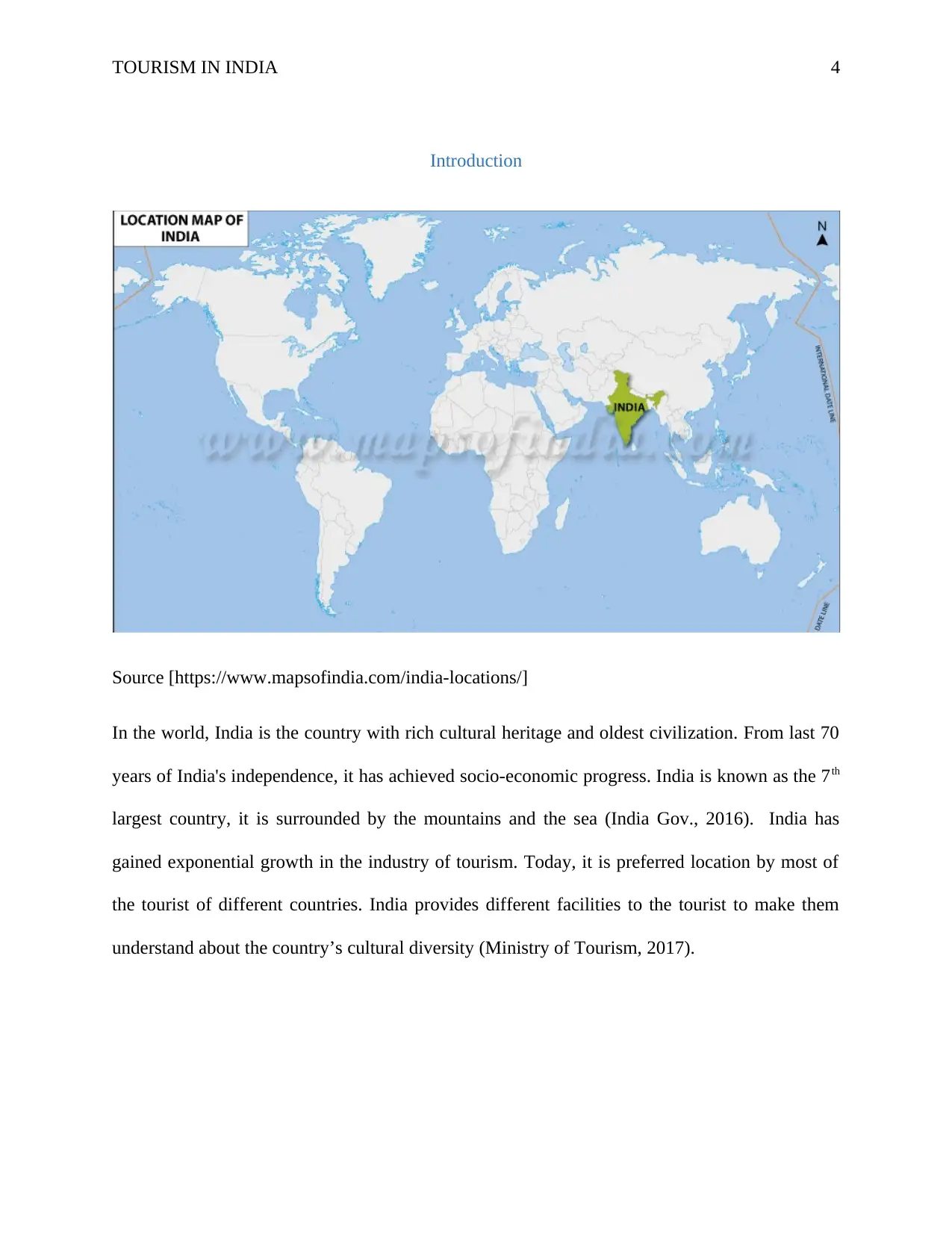
TOURISM IN INDIA 4
Introduction
Source [https://www.mapsofindia.com/india-locations/]
In the world, India is the country with rich cultural heritage and oldest civilization. From last 70
years of India's independence, it has achieved socio-economic progress. India is known as the 7th
largest country, it is surrounded by the mountains and the sea (India Gov., 2016). India has
gained exponential growth in the industry of tourism. Today, it is preferred location by most of
the tourist of different countries. India provides different facilities to the tourist to make them
understand about the country’s cultural diversity (Ministry of Tourism, 2017).
Introduction
Source [https://www.mapsofindia.com/india-locations/]
In the world, India is the country with rich cultural heritage and oldest civilization. From last 70
years of India's independence, it has achieved socio-economic progress. India is known as the 7th
largest country, it is surrounded by the mountains and the sea (India Gov., 2016). India has
gained exponential growth in the industry of tourism. Today, it is preferred location by most of
the tourist of different countries. India provides different facilities to the tourist to make them
understand about the country’s cultural diversity (Ministry of Tourism, 2017).
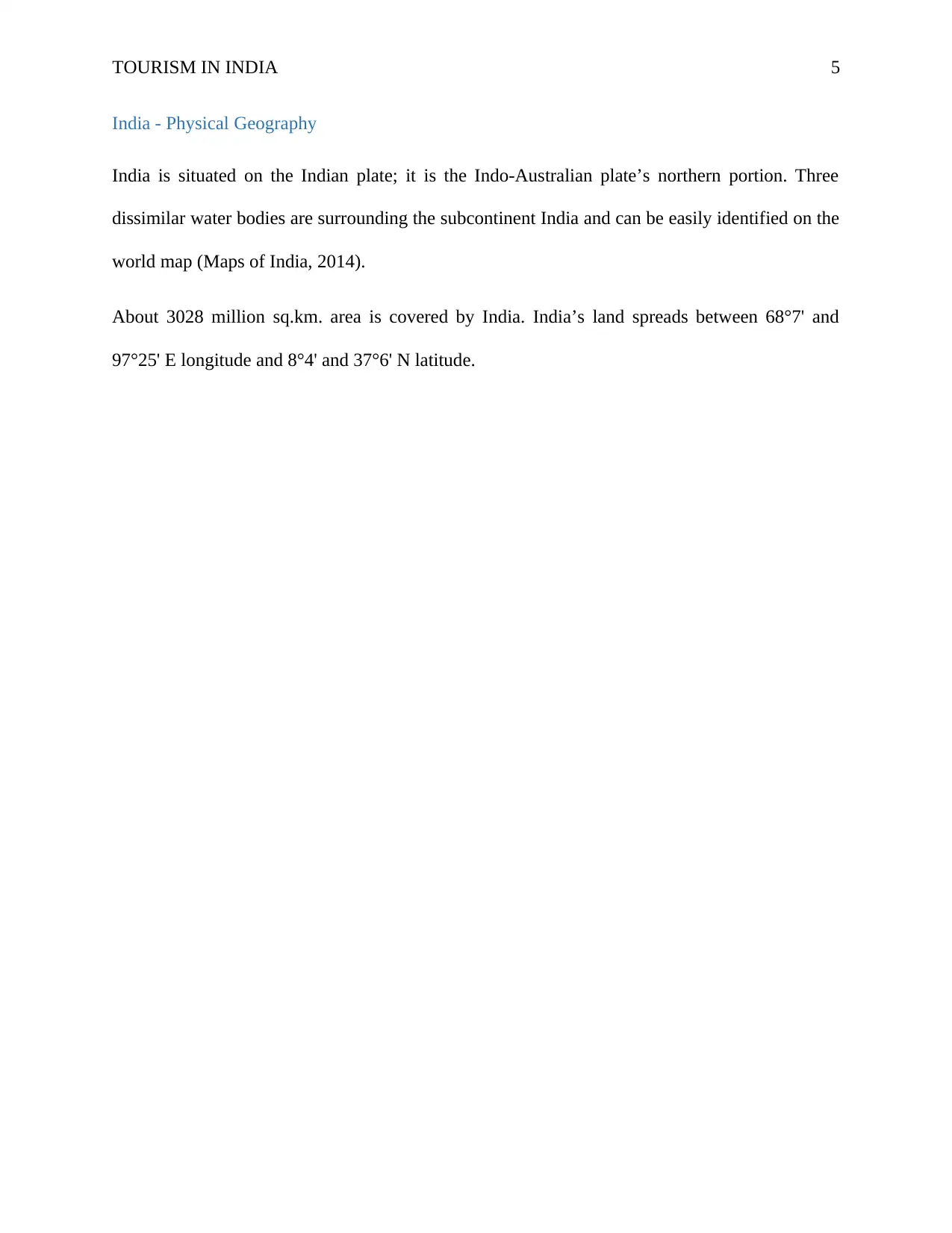
TOURISM IN INDIA 5
India - Physical Geography
India is situated on the Indian plate; it is the Indo-Australian plate’s northern portion. Three
dissimilar water bodies are surrounding the subcontinent India and can be easily identified on the
world map (Maps of India, 2014).
About 3028 million sq.km. area is covered by India. India’s land spreads between 68°7' and
97°25' E longitude and 8°4' and 37°6' N latitude.
India - Physical Geography
India is situated on the Indian plate; it is the Indo-Australian plate’s northern portion. Three
dissimilar water bodies are surrounding the subcontinent India and can be easily identified on the
world map (Maps of India, 2014).
About 3028 million sq.km. area is covered by India. India’s land spreads between 68°7' and
97°25' E longitude and 8°4' and 37°6' N latitude.
⊘ This is a preview!⊘
Do you want full access?
Subscribe today to unlock all pages.

Trusted by 1+ million students worldwide
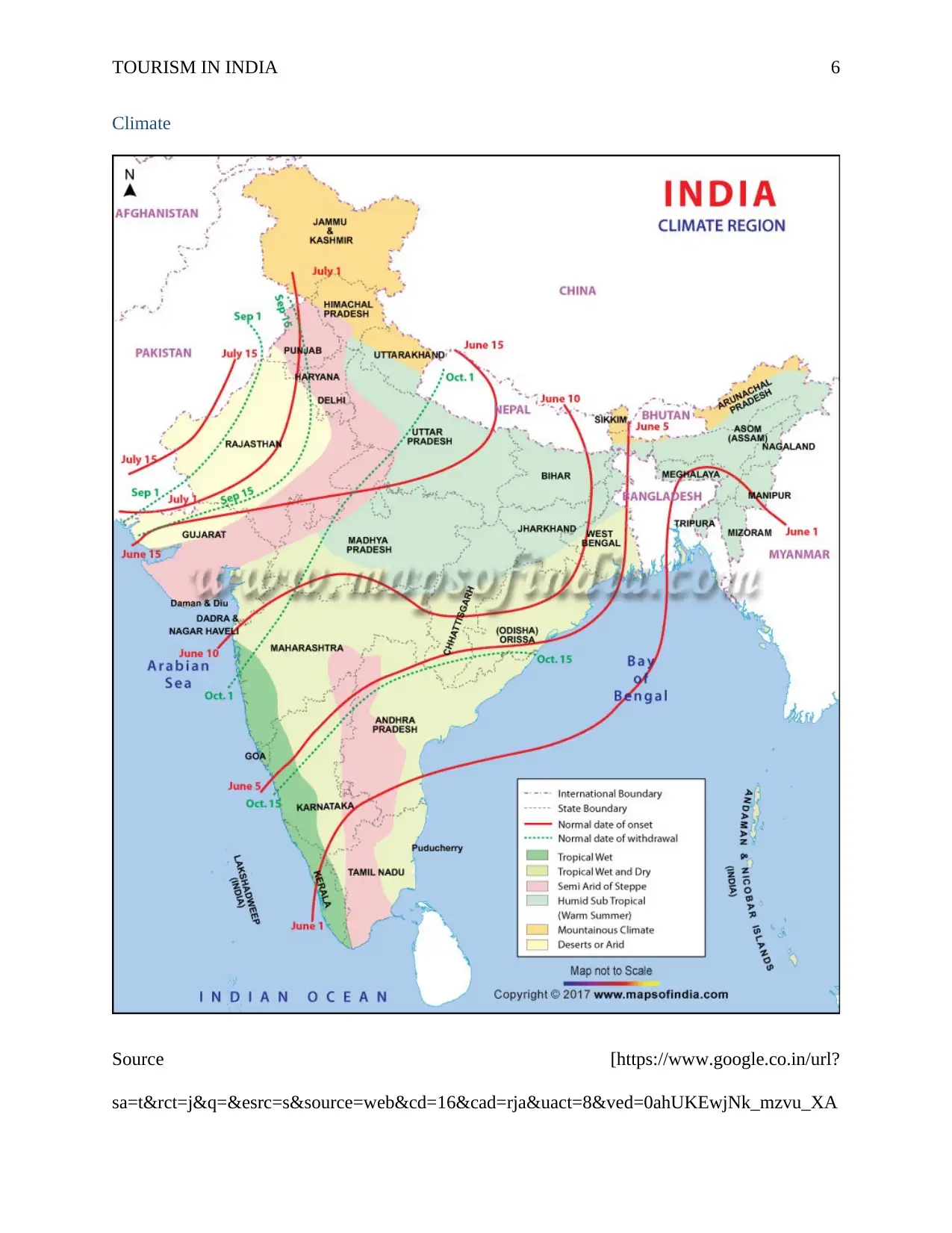
TOURISM IN INDIA 6
Climate
Source [https://www.google.co.in/url?
sa=t&rct=j&q=&esrc=s&source=web&cd=16&cad=rja&uact=8&ved=0ahUKEwjNk_mzvu_XA
Climate
Source [https://www.google.co.in/url?
sa=t&rct=j&q=&esrc=s&source=web&cd=16&cad=rja&uact=8&ved=0ahUKEwjNk_mzvu_XA
Paraphrase This Document
Need a fresh take? Get an instant paraphrase of this document with our AI Paraphraser
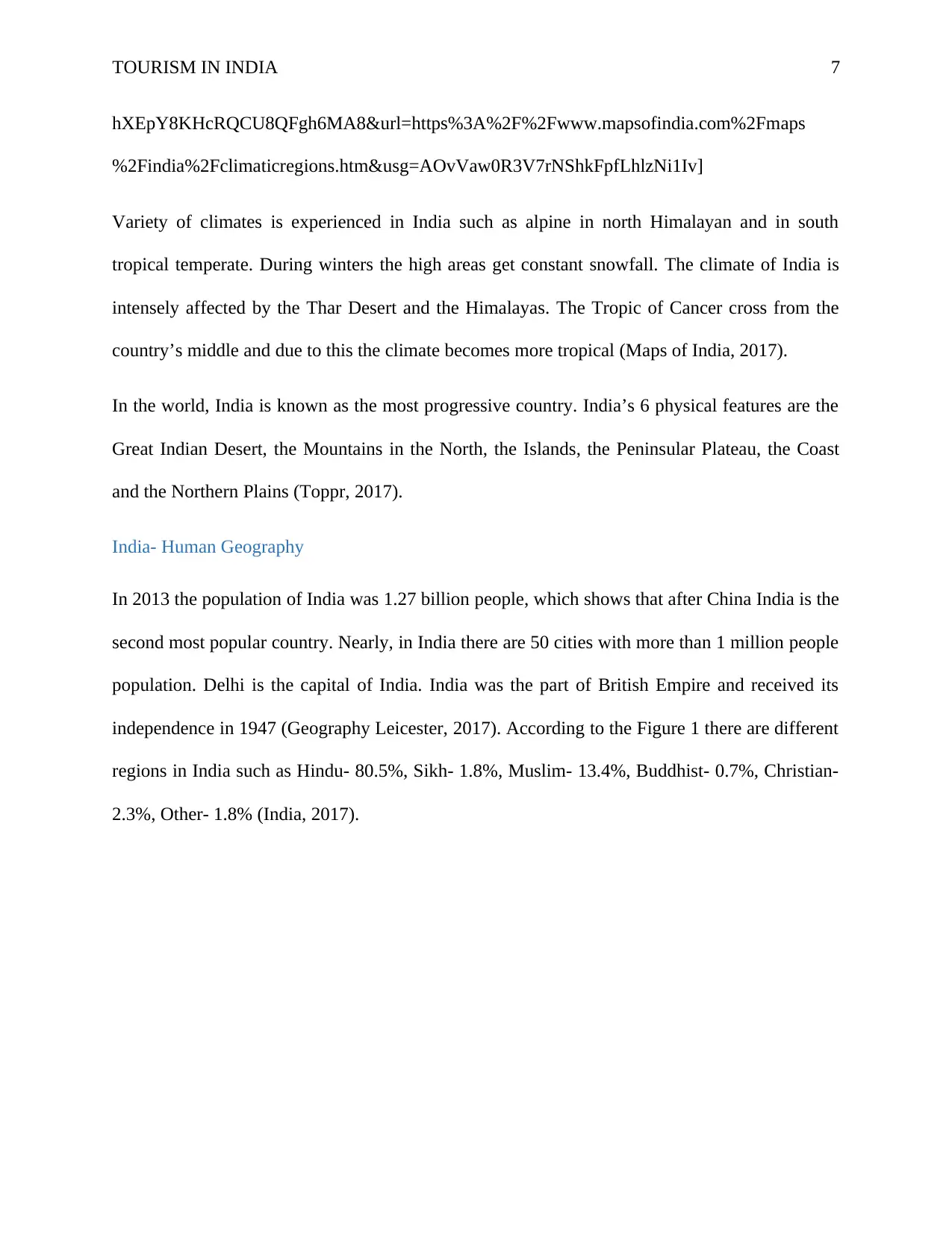
TOURISM IN INDIA 7
hXEpY8KHcRQCU8QFgh6MA8&url=https%3A%2F%2Fwww.mapsofindia.com%2Fmaps
%2Findia%2Fclimaticregions.htm&usg=AOvVaw0R3V7rNShkFpfLhlzNi1Iv]
Variety of climates is experienced in India such as alpine in north Himalayan and in south
tropical temperate. During winters the high areas get constant snowfall. The climate of India is
intensely affected by the Thar Desert and the Himalayas. The Tropic of Cancer cross from the
country’s middle and due to this the climate becomes more tropical (Maps of India, 2017).
In the world, India is known as the most progressive country. India’s 6 physical features are the
Great Indian Desert, the Mountains in the North, the Islands, the Peninsular Plateau, the Coast
and the Northern Plains (Toppr, 2017).
India- Human Geography
In 2013 the population of India was 1.27 billion people, which shows that after China India is the
second most popular country. Nearly, in India there are 50 cities with more than 1 million people
population. Delhi is the capital of India. India was the part of British Empire and received its
independence in 1947 (Geography Leicester, 2017). According to the Figure 1 there are different
regions in India such as Hindu- 80.5%, Sikh- 1.8%, Muslim- 13.4%, Buddhist- 0.7%, Christian-
2.3%, Other- 1.8% (India, 2017).
hXEpY8KHcRQCU8QFgh6MA8&url=https%3A%2F%2Fwww.mapsofindia.com%2Fmaps
%2Findia%2Fclimaticregions.htm&usg=AOvVaw0R3V7rNShkFpfLhlzNi1Iv]
Variety of climates is experienced in India such as alpine in north Himalayan and in south
tropical temperate. During winters the high areas get constant snowfall. The climate of India is
intensely affected by the Thar Desert and the Himalayas. The Tropic of Cancer cross from the
country’s middle and due to this the climate becomes more tropical (Maps of India, 2017).
In the world, India is known as the most progressive country. India’s 6 physical features are the
Great Indian Desert, the Mountains in the North, the Islands, the Peninsular Plateau, the Coast
and the Northern Plains (Toppr, 2017).
India- Human Geography
In 2013 the population of India was 1.27 billion people, which shows that after China India is the
second most popular country. Nearly, in India there are 50 cities with more than 1 million people
population. Delhi is the capital of India. India was the part of British Empire and received its
independence in 1947 (Geography Leicester, 2017). According to the Figure 1 there are different
regions in India such as Hindu- 80.5%, Sikh- 1.8%, Muslim- 13.4%, Buddhist- 0.7%, Christian-
2.3%, Other- 1.8% (India, 2017).
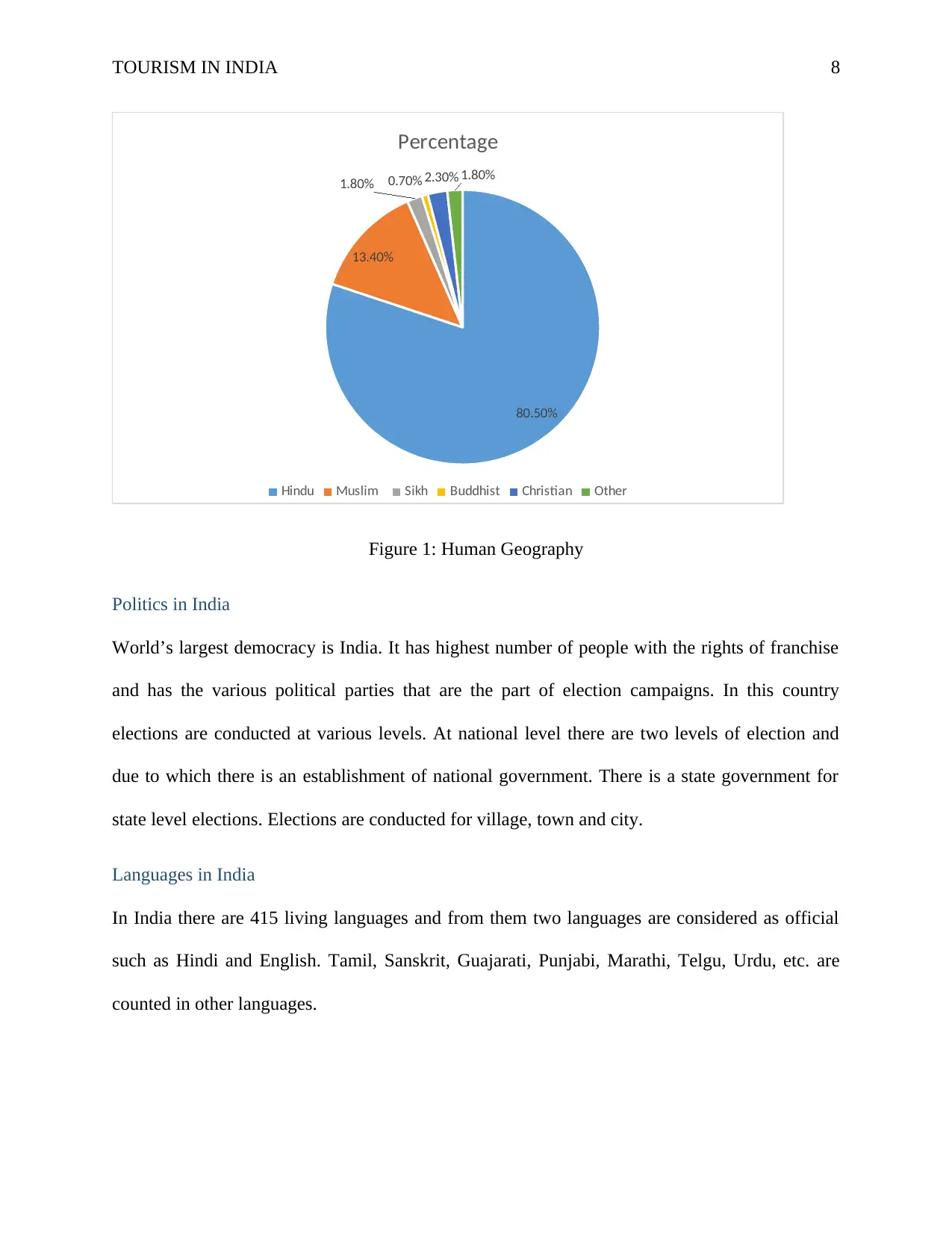
TOURISM IN INDIA 8
80.50%
13.40%
1.80% 0.70% 2.30% 1.80%
Percentage
Hindu Muslim Sikh Buddhist Christian Other
Figure 1: Human Geography
Politics in India
World’s largest democracy is India. It has highest number of people with the rights of franchise
and has the various political parties that are the part of election campaigns. In this country
elections are conducted at various levels. At national level there are two levels of election and
due to which there is an establishment of national government. There is a state government for
state level elections. Elections are conducted for village, town and city.
Languages in India
In India there are 415 living languages and from them two languages are considered as official
such as Hindi and English. Tamil, Sanskrit, Guajarati, Punjabi, Marathi, Telgu, Urdu, etc. are
counted in other languages.
80.50%
13.40%
1.80% 0.70% 2.30% 1.80%
Percentage
Hindu Muslim Sikh Buddhist Christian Other
Figure 1: Human Geography
Politics in India
World’s largest democracy is India. It has highest number of people with the rights of franchise
and has the various political parties that are the part of election campaigns. In this country
elections are conducted at various levels. At national level there are two levels of election and
due to which there is an establishment of national government. There is a state government for
state level elections. Elections are conducted for village, town and city.
Languages in India
In India there are 415 living languages and from them two languages are considered as official
such as Hindi and English. Tamil, Sanskrit, Guajarati, Punjabi, Marathi, Telgu, Urdu, etc. are
counted in other languages.
⊘ This is a preview!⊘
Do you want full access?
Subscribe today to unlock all pages.

Trusted by 1+ million students worldwide
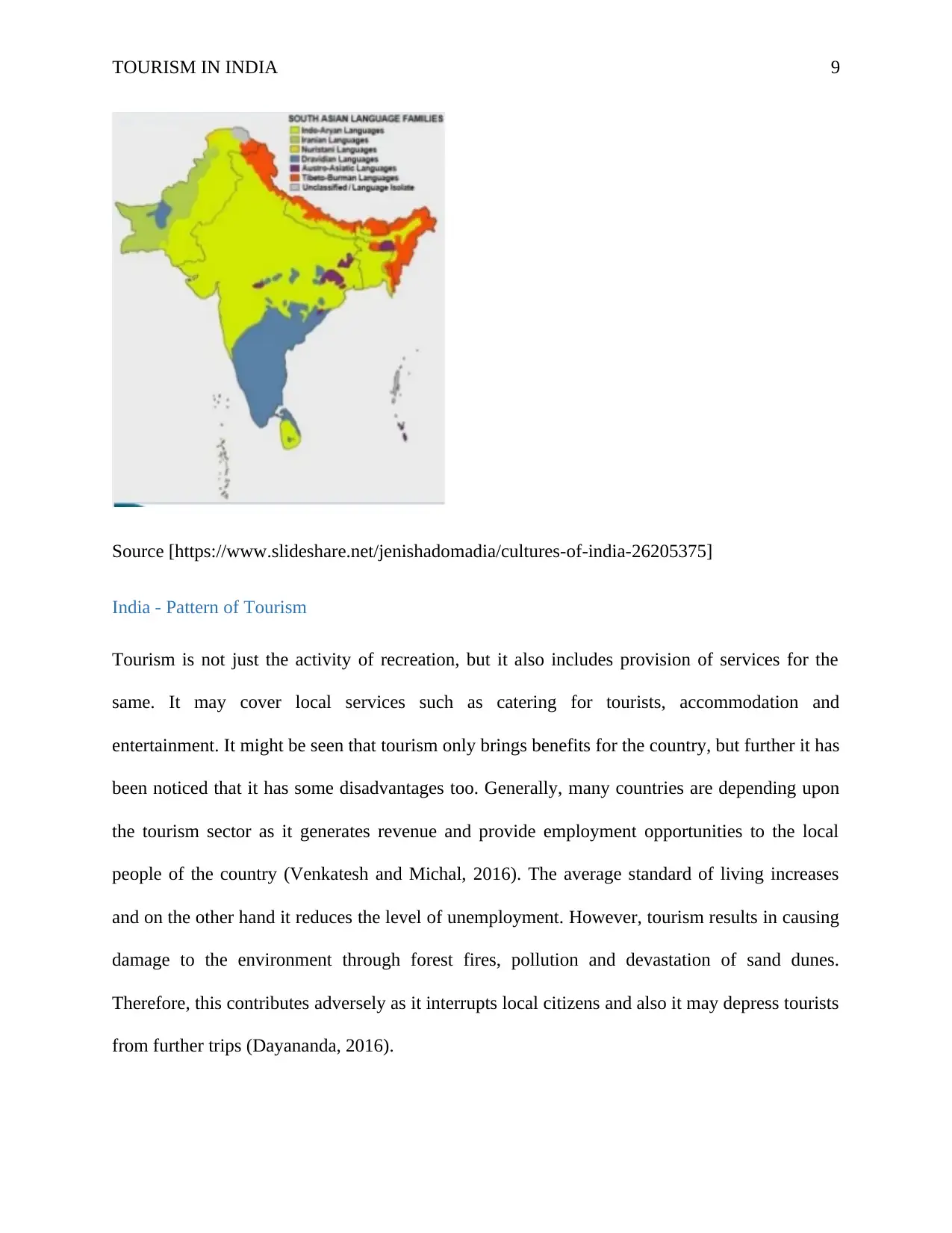
TOURISM IN INDIA 9
Source [https://www.slideshare.net/jenishadomadia/cultures-of-india-26205375]
India - Pattern of Tourism
Tourism is not just the activity of recreation, but it also includes provision of services for the
same. It may cover local services such as catering for tourists, accommodation and
entertainment. It might be seen that tourism only brings benefits for the country, but further it has
been noticed that it has some disadvantages too. Generally, many countries are depending upon
the tourism sector as it generates revenue and provide employment opportunities to the local
people of the country (Venkatesh and Michal, 2016). The average standard of living increases
and on the other hand it reduces the level of unemployment. However, tourism results in causing
damage to the environment through forest fires, pollution and devastation of sand dunes.
Therefore, this contributes adversely as it interrupts local citizens and also it may depress tourists
from further trips (Dayananda, 2016).
Source [https://www.slideshare.net/jenishadomadia/cultures-of-india-26205375]
India - Pattern of Tourism
Tourism is not just the activity of recreation, but it also includes provision of services for the
same. It may cover local services such as catering for tourists, accommodation and
entertainment. It might be seen that tourism only brings benefits for the country, but further it has
been noticed that it has some disadvantages too. Generally, many countries are depending upon
the tourism sector as it generates revenue and provide employment opportunities to the local
people of the country (Venkatesh and Michal, 2016). The average standard of living increases
and on the other hand it reduces the level of unemployment. However, tourism results in causing
damage to the environment through forest fires, pollution and devastation of sand dunes.
Therefore, this contributes adversely as it interrupts local citizens and also it may depress tourists
from further trips (Dayananda, 2016).
Paraphrase This Document
Need a fresh take? Get an instant paraphrase of this document with our AI Paraphraser
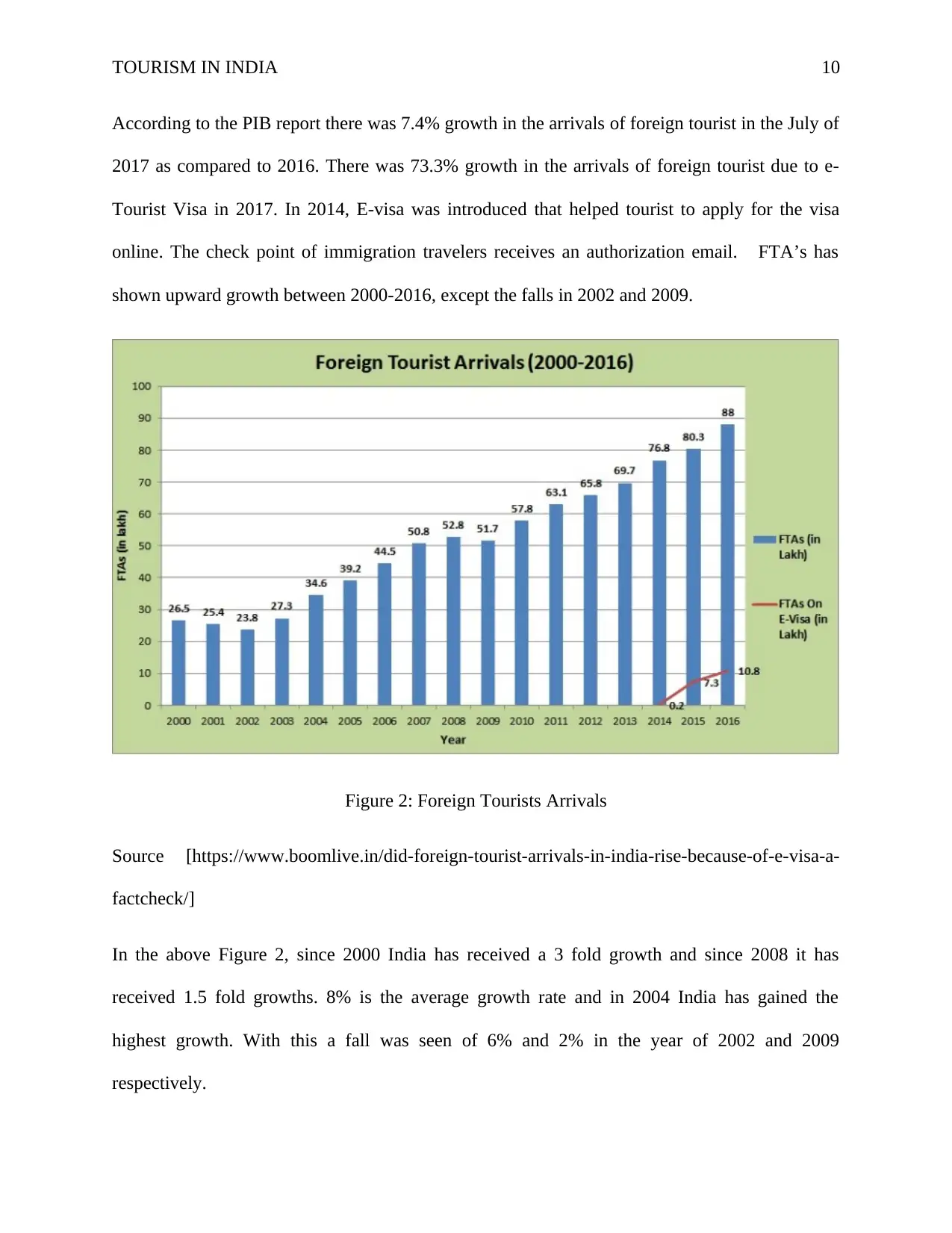
TOURISM IN INDIA 10
According to the PIB report there was 7.4% growth in the arrivals of foreign tourist in the July of
2017 as compared to 2016. There was 73.3% growth in the arrivals of foreign tourist due to e-
Tourist Visa in 2017. In 2014, E-visa was introduced that helped tourist to apply for the visa
online. The check point of immigration travelers receives an authorization email. FTA’s has
shown upward growth between 2000-2016, except the falls in 2002 and 2009.
Figure 2: Foreign Tourists Arrivals
Source [https://www.boomlive.in/did-foreign-tourist-arrivals-in-india-rise-because-of-e-visa-a-
factcheck/]
In the above Figure 2, since 2000 India has received a 3 fold growth and since 2008 it has
received 1.5 fold growths. 8% is the average growth rate and in 2004 India has gained the
highest growth. With this a fall was seen of 6% and 2% in the year of 2002 and 2009
respectively.
According to the PIB report there was 7.4% growth in the arrivals of foreign tourist in the July of
2017 as compared to 2016. There was 73.3% growth in the arrivals of foreign tourist due to e-
Tourist Visa in 2017. In 2014, E-visa was introduced that helped tourist to apply for the visa
online. The check point of immigration travelers receives an authorization email. FTA’s has
shown upward growth between 2000-2016, except the falls in 2002 and 2009.
Figure 2: Foreign Tourists Arrivals
Source [https://www.boomlive.in/did-foreign-tourist-arrivals-in-india-rise-because-of-e-visa-a-
factcheck/]
In the above Figure 2, since 2000 India has received a 3 fold growth and since 2008 it has
received 1.5 fold growths. 8% is the average growth rate and in 2004 India has gained the
highest growth. With this a fall was seen of 6% and 2% in the year of 2002 and 2009
respectively.
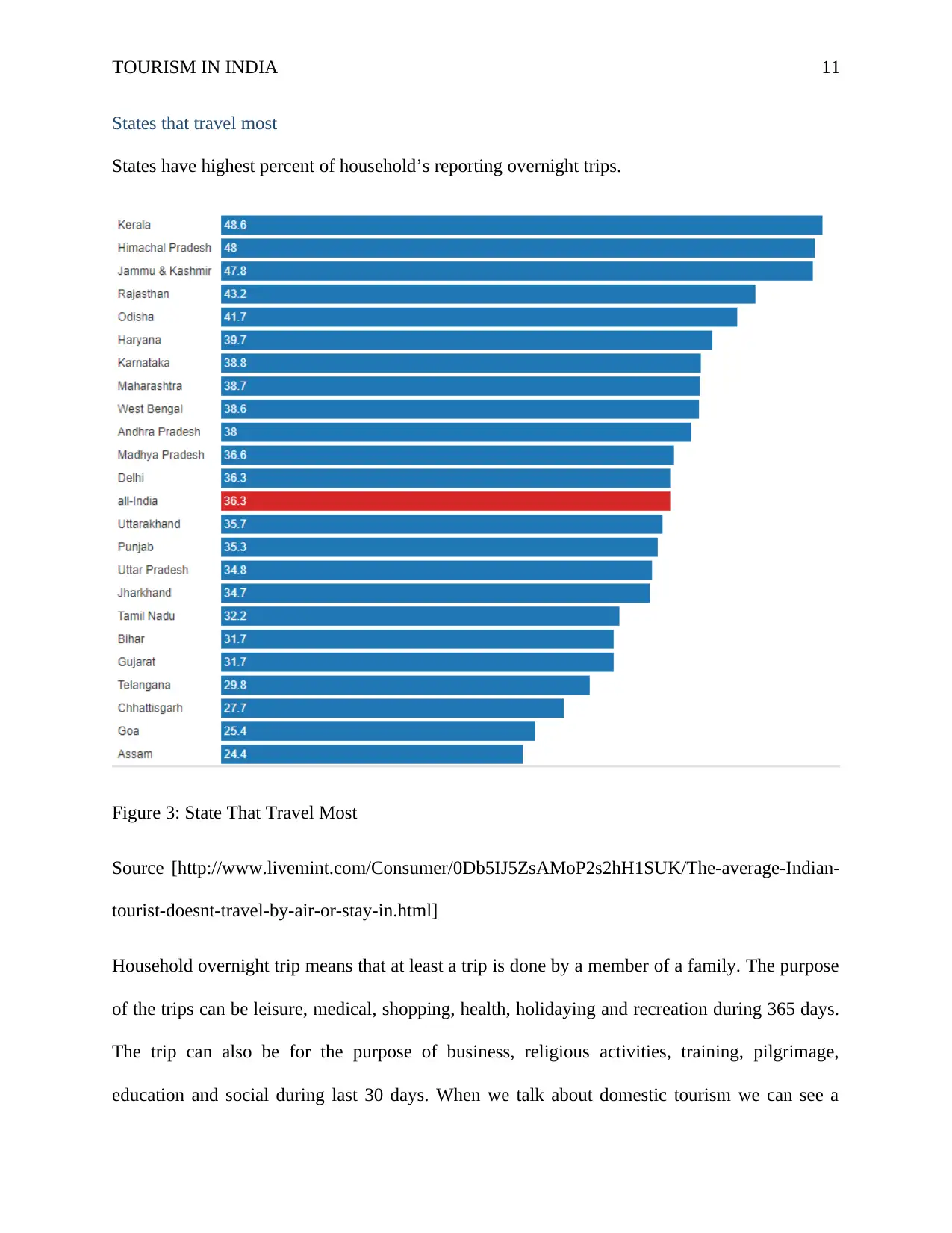
TOURISM IN INDIA 11
States that travel most
States have highest percent of household’s reporting overnight trips.
Figure 3: State That Travel Most
Source [http://www.livemint.com/Consumer/0Db5IJ5ZsAMoP2s2hH1SUK/The-average-Indian-
tourist-doesnt-travel-by-air-or-stay-in.html]
Household overnight trip means that at least a trip is done by a member of a family. The purpose
of the trips can be leisure, medical, shopping, health, holidaying and recreation during 365 days.
The trip can also be for the purpose of business, religious activities, training, pilgrimage,
education and social during last 30 days. When we talk about domestic tourism we can see a
States that travel most
States have highest percent of household’s reporting overnight trips.
Figure 3: State That Travel Most
Source [http://www.livemint.com/Consumer/0Db5IJ5ZsAMoP2s2hH1SUK/The-average-Indian-
tourist-doesnt-travel-by-air-or-stay-in.html]
Household overnight trip means that at least a trip is done by a member of a family. The purpose
of the trips can be leisure, medical, shopping, health, holidaying and recreation during 365 days.
The trip can also be for the purpose of business, religious activities, training, pilgrimage,
education and social during last 30 days. When we talk about domestic tourism we can see a
⊘ This is a preview!⊘
Do you want full access?
Subscribe today to unlock all pages.

Trusted by 1+ million students worldwide
1 out of 16
Related Documents
Your All-in-One AI-Powered Toolkit for Academic Success.
+13062052269
info@desklib.com
Available 24*7 on WhatsApp / Email
![[object Object]](/_next/static/media/star-bottom.7253800d.svg)
Unlock your academic potential
Copyright © 2020–2025 A2Z Services. All Rights Reserved. Developed and managed by ZUCOL.




